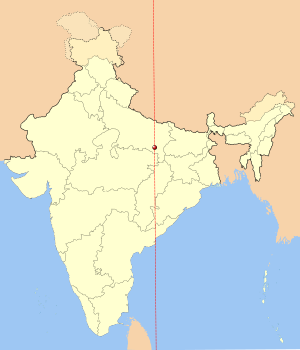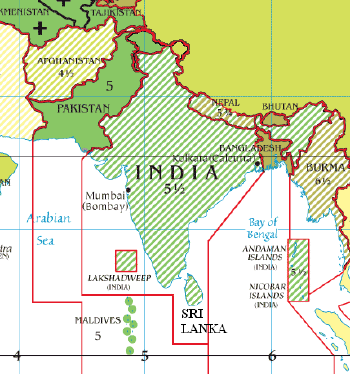Indian Standard Time
Indian Standard Time (IST) represents the time observed throughout India, with a time offset of UTC+5:30. India does not observe daylight saving time, (DST) or other seasonal adjustments. In military and aviation time, E* ("Echo-Star") designates IST.[1]
Indian Standard Time calculates on the basis of 82.5° E longitude, just west of the town of Mirzapur, near Allahabad in the state of Uttar Pradesh. The longitude difference between Mirzapur and the United Kingdom's Royal Observatory at Greenwich translates to an exact time difference of 5 hours 30 minutes. A clock tower at the Allahabad Observatory () calculates local time, though the National Physical Laboratory, in New Delhi has been entrusted with the official time-keeping devices.[2]
History
One of the earliest descriptions of standard time in India appeared in the fourth century C.E. astronomical treatise Surya Siddhanta. Postulating a spherical earth, the book defined the prime meridian, or zero longitude, as passing through Avanti, the ancient name for the historic city of Ujjain, and Rohitaka, the ancient name for Rohtak, a city near the historic battle-field of Kurukshetra.[3]
Situated upon the line which passes through the haunt of the demons (equator and 76° E) and the mountain which is the seat of the gods (the North Pole), are Rohitaka and Avanti …[4]
The day used by ancient Indian astronomers began at sunrise at the prime meridian of Ujjain,[5] which they divided into smaller time units in the following manner:[6]
Time that is measurable is that which is in common use, beginning with the prāṇa (or, the time span of one breath). The pala contains six prāṇas. The ghalikā is 60 palas, and the nakṣatra ahórātra, or astronomical day, contains 60 ghalikās. A nakṣatra māsa, or astronomical month, consists of 30 days.
Measuring a day as twenty four hours, the smallest time unit, prāṇa, or one respiratory cycle, equals four seconds, a value consistent with the normal breathing frequency of fifteen breaths/min used in modern medical research.[7] The Surya Siddhanta also described a method of converting local time to the standard time of Ujjain.[4] Despite those early advances, only astronomers commonly used standard time. For most of India's history, ruling kingdoms kept their own local time, typically using the Hindu calendar in both lunar and solar units. For example, the Jantar Mantar observatory built by Maharaja Sawai Jai Singh in Jaipur in 1733 contains large sundials, up to 90 ft (27 m) high, used to accurately determine the local time.
In 1792, the British East India Company established the Madras Observatory in Chennai (then Madras), largely due to the efforts of the British sailor–astronomer Michael Topping. In 1802, John Goldingham, appointed as the first official astronomer of the Company in India, established the longitude of Madras as 5 hours 30 minutes ahead of Greenwich Mean Time as the local standard time. That marked the first use of the current time zone, and departure from the earlier standard of the day beginning at sunrise; now it started at midnight. The clock in the observatory attached to a gun that fired at 8 p.m. daily to announce that "all was well" with IST. Time-keeping support for shipping activities in Bombay Harbor was provided by the Colaba Observatory in Bombay, which was established in 1826.
Most towns in India retained their own local time until a few years after the introduction of the railways in the 1850s, when the need for a unified time zone became apparent. Local time in Mumbai (then Bombay) and Kolkata (then Calcutta), as headquarters of the two largest Presidencies of British India, assumed special importance, the nearby provinces and princely states gradually adopted the standard. In the nineteenth century, telegraph kept the clocks in synchronization– for example the railways synchronized their clocks thorough a time signal sent from the head office or the regional headquarters at a specified time every day.[8]
In 1884, the International Meridian Conference in Washington, D.C. set up uniform time zones across the world, India receiving two time zones, with Calcutta using the 90th east meridian and Bombay the 75° E meridian. The Conference set Calcutta time at 5 hours 30 minutes 21 seconds ahead of GMT, while setting Bombay time at 4 hours 51 minutes ahead.[9] By the late 1880s, many railway companies began to use Madras time (known as "Railway time") as an intermediate time between the two zones. The British colonial government established another time zone, Port Blair mean time, established at Port Blair, the capital of the Andaman and Nicobar Islands in the Bay of Bengal. They set Port Blair mean time to 49 minutes 51 seconds ahead of Madras time.[10]
British India officially adopted the standard time zones in 1905, when picking the meridian passing east of Allahabad at 82.5° E longitude as the central meridian for India, corresponding to a single time zone for the country. That came into force on January 1, 1906, also applying to Sri Lanka (then Ceylon). Calcutta time remained as an official, separate time zone until 1948.[8]
In 1925, the government began relaying time synchronization through omnibus telephone systems and control circuits to organizations that needed to know the precise time. That continued until the 1940s, when the government began to broadcast time signals using the radio.[8]
After independence in 1947, the Indian government established IST as the official time for the whole country, although Kolkata and Mumbai retained their own local time for a few more years.[8] The Central observatory moved from Chennai to a location near Mirzapur, as close as possible to UTC +5:30.
During the Sino–Indian War of 1962 and the Indo–Pakistani Wars of 1965 and 1971, the government resorted briefly to daylight saving time as a way of reducing civilian energy consumption.
Problems
The country's east–west distance of more than 2,000 km (1,200 miles) covers over 28 degrees of longitude, resulting in the sun rising and setting almost two hours earlier in the north-eastern Seven Sister States than in the Rann of Kutch in the far west. In the late 1980s, a team of researchers proposed separating the country into two or three time zones to conserve energy. The binary system that they suggested involved a return to British–era time zones; the government rejected the recommendations adopted.[2]
In 2001, the government established a four–member committee under the Ministry of Science and Technology to examine the need for multiple time zones and daylight saving.[2] The findings of the committee, presented to Parliament by the Minister for Science and Technology, Kapil Sibal, recommended maintaining the current unified system, stating that "the prime meridian was chosen with reference to a central station, and that the expanse of the Indian State was not large."[11]
An August 2007 article in the Current Science journal estimated that the evening peak energy demand could be reduced by as much as 16 percent by setting Indian Standard Time six hours ahead of Universal Coordinated Time instead of the present 5.5 hours. According to the authors, the money value of the savings accrued as a result of the time change would be in the range of Rs 1,000 crore every year.[12]
Time signals
The Time and Frequency Standards Laboratory at the National Physical Laboratory in New Delhi generate official time signals for both commercial and official use. The signals, based on atomic clocks, synchronize with the worldwide system of clocks that support the Coordinated Universal Time.
Features of the Time and Frequency Standards Laboratory include:[13]
- Four caesium and rubidium atomic clocks
- High frequency broadcast service operating at 10 MHz under call sign ATA to synchronize the user clock within a millisecond
- Indian National Satellite System satellite–based standard time and frequency broadcast service, which offers IST correct to ±10 microsecond and frequency calibration of up to ±10−10
- Time and frequency calibrations made with the help of pico– and nanoseconds time interval frequency counters and phase recorders
The state–owned All India Radio and Doordarshan television network broadcast the exact time. Telephone companies have dedicated phone numbers connected to mirror time servers that also relay the precise time. Obtaining the time through Global Positioning System (GPS) receivers offers another increasingly popular method.
Notes
- ↑ Military and Civilian Time Designations Greenwich Mean Time. Retrieved April 25, 2023.
- ↑ 2.0 2.1 2.2 India investigates different time zones BBC, August 21, 2001. Retrieved April 25, 2023.
- ↑ Olaf H. Schmidt, The Computation of the Length of Daylight in Hindu Astronomy, Isis 35(3) (1944): 205–211.
- ↑ 4.0 4.1 Ebenezer Burgess, "Translation of the Surya Siddhanta, A Text-Book of Hindu Astronomy; With Notes, and an Appendix," Journal of the American Oriental Society 6 (1935): 141–498.
- ↑ N. Swerdlow, "A Lost Monument of Indian Astronomy," Isis 64(2) (1973): 239–243.
- ↑ Sukumar Ranjan Das, "The Equation of Time in Hindu Astronomy," The American Mathematical Monthly 35 (10) (1928): 540–543.
- ↑ M. Piepoli, "Origin of Respiratory Sinus Arrhythmia in Conscious Humans," Circulation 95 (1997): 1813–1821. Retrieved April 25, 2023.
- ↑ 8.0 8.1 8.2 8.3 Odds and Ends Indian Railways Fan Club (IRFCA). Retrieved April 25, 2023.
- ↑ Indian Time Zones (IST) Project Gutenberg. Retrieved April 25, 2023.
- ↑ R.D. Oldham, Note on the earthquake of December 31, 1881 Records of the Geological Survey of India XVII(2) (1884): 47–53. Retrieved April 25, 2023.
- ↑ Does India Need Separate Time Zones? The Logical Indian, November 9, 2017. Retrieved April 25, 2023.
- ↑ Scientists suggest pushing IST to save energy The Times of India, September 2, 2007. Retrieved April 25, 2023.
- ↑ Time in India Greenwich Mean Time. Retrieved April 25, 2023.
ReferencesISBN links support NWE through referral fees
- Bartky, Ian R. One Time Fits All the Campaigns for Global Uniformity. Stanford, CA: Stanford University Press, 2007. ISBN 9780804756426
- Blaise, Clark. Time Lord Sir Sandford Fleming and the Creation of Standard Time. New York: Pantheon Books, 2000. ISBN 9780375401763
- Vij, Brij Bhushan. Towards a Unified Technology if Time Standard Went Metric. New Delhi: Soni Book Agency (India), 1982. ASIN B0006EC5B2
External links
All links retrieved April 18, 2023.
- Time in India Greenwich Mean Time.
- 1st September 1947: Indian Standard Time is introduced Maps of India
Credits
New World Encyclopedia writers and editors rewrote and completed the Wikipedia article in accordance with New World Encyclopedia standards. This article abides by terms of the Creative Commons CC-by-sa 3.0 License (CC-by-sa), which may be used and disseminated with proper attribution. Credit is due under the terms of this license that can reference both the New World Encyclopedia contributors and the selfless volunteer contributors of the Wikimedia Foundation. To cite this article click here for a list of acceptable citing formats.The history of earlier contributions by wikipedians is accessible to researchers here:
The history of this article since it was imported to New World Encyclopedia:
Note: Some restrictions may apply to use of individual images which are separately licensed.

